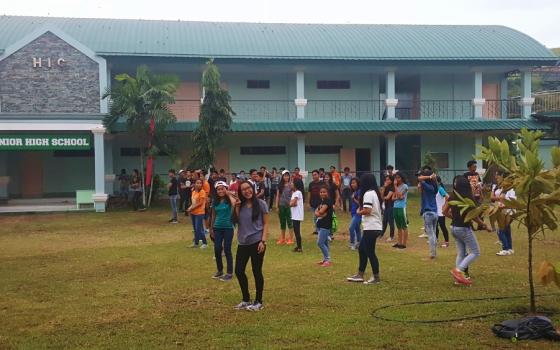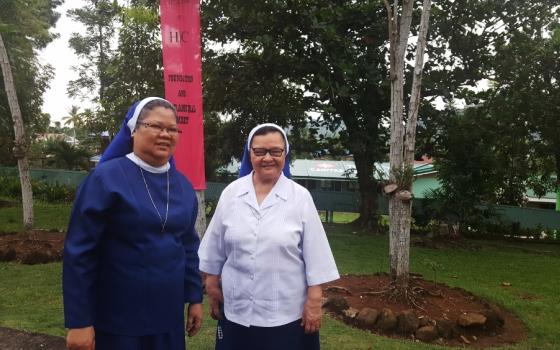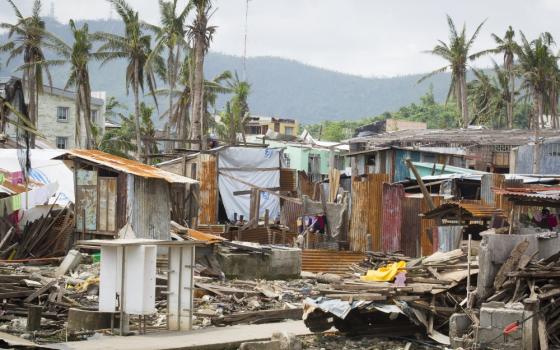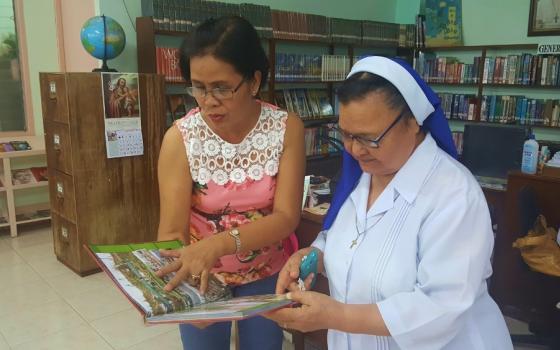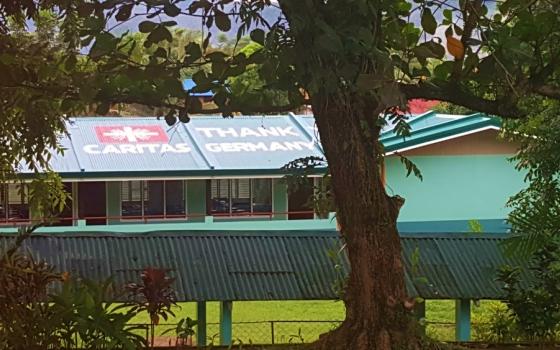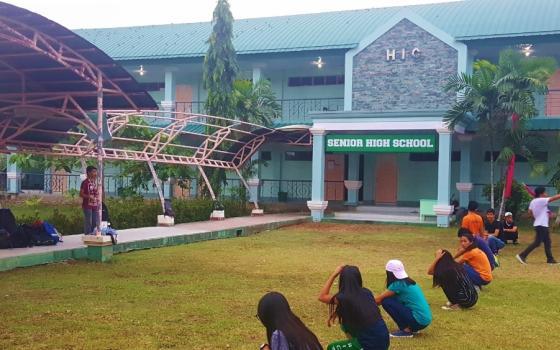Sr. Mary Carmela N. Cabactulan stepped outside the Sisters of Mercy convent in Tacloban November 8, 2013, to face the biggest crisis in her more than 40 years as a member and now leader of her community. The raging winds of Typhoon Haiyan had ripped off roofs, shattered walls and left the buildings of the school that had served 1,500 students in shambles under a thicket of fallen trees and debris. Damaged, too, was the adjacent 50-bed hospital the sisters ran.
"Sisters had gone ahead and they were saying, 'our school is gone, Sister. Our school is really gone,'" she remembers. "I went down and I couldn't see anything because it was covered with trees." She didn't recognize the school, she said, and was unable to even see the roads because of all the fallen trees. More frightening, "I really didn't know what to do," she said. "We had no money, no way to rebuild."
Three years later, happy shouts of "Sister, Sister," greet her as she walks through the school grounds where students compete in sports, games and dance contests as part of an intramural and physical education festival. Newly planted trees, a building that still is not fully repaired, and roofs painted with "Thank you Caritas Germany" are the only signs on the campus of the trauma that gripped the sisters' community and the surrounding region from the super typhoon.
Locally known as Yolanda, the storm packed winds of 195 miles per hour (315 kph) with gusts as strong as 235 miles per hour (380 kph), whipping through the central Philippines and the island of Leyte and causing a 20-foot storm surge (nearly 7 meters) that laid waste to much of Tacloban and neighboring communities. At least 6,300 people were killed — with some estimates as high as 10,000 or more —and more than 70 percent of buildings were damaged or destroyed.
Cabactulan and Sr. Marian Ladrera, who took over as superior general in December 2015, say they had prepared as usual for the typhoon, with three-days' worth of food supplies and securing the buildings best as they could. But nothing could have prepared them for the damage caused by Haiyan.
Immediate needs took precedence. Relatives of some of the sisters arrived at the convent, seeking help and telling of dead bodies in the streets and chaos gripping the area. The sisters provided them meals and a change of clothes. By the afternoon, Cabactulan was told the hospital needed food for patients who were crowding into the facility. She and an ambulance driver carefully made their way to the airport to get rice that the government was providing to hospitals.
By evening, a crowd had taken over the convent chapel, filling staircases and corridors and threatening to break into the convent itself. The sisters barred the doors and boarded up passageways. "It's not that we didn't want the people to come in but we needed to have some control," Cabactulan said.
Cabactulan tried to reason with the group to leave the sisters' rooms alone since there was little in them and they were private. She remembers one frantic man yelled, "There is no privacy, this is an emergency," and pushed the door as the mob tried to force its way in.
The barriers held. "It's good I was able to protect myself otherwise I would have easily fallen down the stairs," she said. "I thought, 'this is what happens in an emergency.'" The sisters slept in the living and dining rooms for safety and mutual support. By morning, the crowd had dispersed, but umbrellas, shoes and other items were missing from the chapel, including Cabactulan's new Bible.
The hospital, also badly damaged, was operating without lights or running water. Cabactulan wasn't sure the mission of running the school and hospital could continue. Having heard of rapes and looting in the area, she wondered if the community of 26 sisters, the core of the roughly 49 Mercy Sisters throughout the Philippines, should leave.
The thought weighed heavily on her. She felt the responsibility of carrying on the legacy of the six pioneer sisters who had arrived in Tacloban from Cork, Ireland, in 1954 at the invitation of the then-bishop of Palo. The sisters took over the school, which had been founded in 1924 and first managed by the Order of St. Benedict Sisters.
"I was scared for the sisters," she said. "Even our guards were helpless to guard this place. It was very difficult." She prayed: "'Lord, if you want us to stay, show me what to do. If you do not want us to leave this place, help us recover. Help us find a way to recover because I don't know how to do it.' I would have second thoughts about leaving. This was our motherhouse, this is where I was called to serve — and then all was gone."
Cabactulan told teachers, staff and parents that the school was closed indefinitely, offering to help them transfer to other schools elsewhere in the Philippines. Just a few teachers transferred. "They were crying, it was very difficult," she remembers. She told the sisters they could move to other Mercy houses if they chose.
Over the next weeks, the answers came. A German medical group, Humedica, offered to pay the hospital's doctors and nurses, covering their costs for three months. Then Cabactulan got an email from St. Maurice Catholic Church, a South Florida parish that for years had supported a Saturday meal program the sisters run that feeds about 500 street children.
The Dania Beach, Florida, parish said they had heard of damages and offered to pay her travel costs if she wanted to come to raise funds to rebuild. She consulted with the sisters and it was decided she should go. Traveling was hard because of her own physical pain, but she knew this was the resolution she'd been praying for.
While in the U.S., she called her brother, Libran Cabactulan, who was then the Philippines ambassador to the United Nations. His wife Remedios Fe, was the president of the U.N. Delegation's Women's Club. They scheduled a fundraiser in New York and a distant relative in Tampa offered to pay for travel costs to New York and Tampa for a fundraiser there, too.
The Dania Beach, Florida, parish had heard of the damages and offered to pay her costs if she wanted to come to raise funds to rebuild. "The destruction was unbelievable," said Cecile Erlsten, chairperson of the St. Maurice Hunger Program which has supported the Mercy Sisters feeding program in Tacloban since the mid-1970s, one of 22 hunger projects the parish supports in the Philippines, Central and South America, Haiti and South Florida. "When she showed those pictures it created an awareness for us. We were so proud to help with what little we could."
Between all the trips, she raised about $40,000 — enough to get started on initial rebuilding. But more, the answer to her prayers was clear: they would stay and rebuild. Funding from Caritas Germany helped to repair the hospital and the remainder needed for the school.
"Sr. Carmela is very near and dear to us," Erlsten said. "She has a commitment to God, to her order and more than anything she has a commitment to the poor. People like Sister give the victims the affirmation and the caring that it’s going to be okay, that they will get through it. To be OK — that we will get through it."
By January 2014, while rebuilding was still underway, the school reopened with classes in repaired sections. The school, which serves elementary through college students, has about 1,100 students now, down from the 1,600 before the storm. The hospital has grown to about 100 beds, up from 50 before the storm.
Looking around the repaired buildings, Ladrera said "it is in better shape, but we feel sad for those who died — it's really very sad." One employee is missing and presumed dead. A sister lost her mother. One blessing, the sisters say, is that no students became orphaned because of the storm.
The visit of Pope Francis in January 2015 was very healing, said Ladrera, who was asked to help with the reading of petitions during the papal Mass. "After Yolanda, people were so tired," she said. "We felt very sad. When Pope Francis came, the experience was so different." Even as another typhoon threatened and cut short his visit, the people didn't want to leave. "There was really joy," Ladrera said. "We became hopeful then."
Having been the recipient of so much charity, now the Mercy Sisters are preparing to give back. They launched a program in September in partnership with Caritas Germany to help street children in Tacloban, some of whom were left vulnerable by Typhoon Haiyan, having lost families or housing. The sisters have hired a part-time licensed social worker and a teacher with experience as a lay missionary to help with the program. They envision hiring a full-time licensed social worker in the future.
The intention is to make it a community project for the school, drawing in particular on the approximately 500 college students. Student nurses can help with health concerns; education students can help with tutoring, while others can help with sports and skills training.
The Mercy Sisters are also part of a local organization of sisters from 20 orders — up from 14 in the area before the storm — who respond to local tragedies or disasters. When a fire ravaged a house recently, for instance, the sisters' organization helped the family.
Efforts like this help live out one of the typhoon's lasting lessons, which is about faith, Cabactulan said. "Things happen and we're not prepared but then the Lord will always provide."
[Gail DeGeorge is editor of Global Sisters Report. Her email address is [email protected]. Follow her on Twitter: @GailDeGeorge.]
